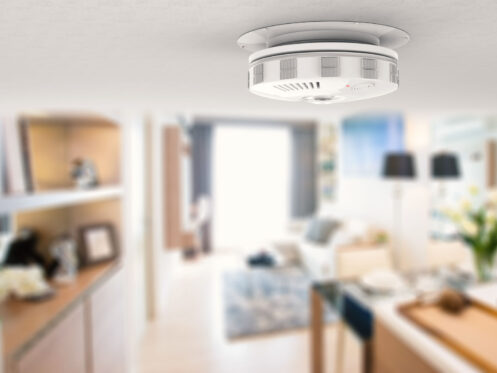Carbon monoxide is a leading cause of poisoning death in the United States. According to the Center for Disease Control (CDC), over 400 people in the United States die each year from accidental carbon monoxide poisoning. The CDC also reports that more than 100,000 people visit the emergency department each year due to carbon monoxide exposure. Unfortunately, carbon monoxide exposure can occur from use of everyday objects in our homes. A look at the best ways to shield your home from the risks of carbon monoxide exposure can provide a blueprint for a safe home.
What Is Carbon Monoxide?
Carbon monoxide (CO) is a colorless, odorless, and tasteless gas that forms due to the incomplete combustion of fuels. The molecular composition of carbon monoxide consists of one carbon atom and one oxygen atom connected via a triple bond. Any burning fuel such as gas, wood, propane, or charcoal can produce carbon monoxide. Appliances, machines, or engines that are defective or lack proper exhaust or ventilation can cause CO to build up to dangerous levels. Fuel that burns within a tightly enclosed space can make CO buildup even worse. Common sources of carbon monoxide within the home include the following:
- Gas-burning or wood-burning stoves and ovens
- Furnaces or boilers
- Gas-burning or wood burning fireplaces
- Water heaters
- Space heaters
- Backup generators
- Clothes dryers
- Power tools and lawn equipment
- Charcoal and propane grills
- Fuel-burning lanterns
- Motor vehicles in the garage
What Are Symptoms of Carbon Monoxide Poisoning?
Carbon monoxide is dangerous because the inhalation of this gas can cause CO to displace oxygen in the human body. Specifically, the body begins to replace the oxygen in the red blood cells with carbon monoxide, and the concentration of CO eventually rises to harmful levels within the bloodstream. This is known as carbon monoxide poisoning. Such poisoning deprives the heart, brain and other vital organs of life-giving oxygen and can cause permanent damage or tissue death. Large concentration of carbon monoxide can cause an individual to lose consciousness and suffocate, and the highest concentrations of CO can kill a person in less than five minutes. Carbon monoxide is called an “invisible killer” because it is undetectable to the human senses, so many people do not realize they have been exposed. Possible symptoms of CO exposure include the following:
- Headache
- Nausea or vomiting
- Dizziness or disorientation
- Shortness of breath
- Blurred vision
- Confusion
- Drowsiness
- Loss of muscle control or coordination
- Loss of consciousness
What Are Ways to Protect My Home From the Dangers of Carbon Monoxide?
While most homes contain fuel-burning machines or appliances, there are several ways to protect your family from the danger of CO poisoning. Steps include installing a carbon monoxide detector, scheduling routine inspection of appliances, and practicing fuel safety.
Install and Maintain Carbon Monoxide Detectors
Contact a professional to install and inspect carbon monoxide detectors. Professionals have the training to install detectors with audible alarms near sleeping areas, on indoor walls near garages, and at the right distance from combustion equipment in your home. You can also ask about having interconnected CO detectors hardwired into your system so that the alarm can alert each level of your home. All carbon monoxide detectors should meet Underwriters Laboratories (UL) standards and include warranties. A technician can test your detectors once a year to ensure continued operation. If the alarm goes off, evacuate the home and have a professional confirm that the area is free of poison before reentering your house.
Schedule Routine Inspection of Major Appliances
Malfunctioning appliances can also cause carbon monoxide exposure. Problems with CO usually arise from improper ventilation, blocked exhaust, or gas leaks. A qualified technician can examine your fuel-burning appliances during annual home services checkups. This process can include testing flue pipes and combustion mechanisms for any defects or problems. If any appliances are past their lifespan, the technician can also install an upgraded machine. Ask your technician about ENERGY STAR appliances that may help burn fuel more efficiently.
Practice Fuel Safety
You can also avoid the pitfalls of carbon monoxide poisoning by practicing fuel safety. For example, never attempt to “warm up” your vehicle or lawnmower by allowing the engine to run in an enclosed garage. This is a fast way to exposure your family to carbon monoxide. If you must use a portable generator during an emergency, keep the device as far away from the home possible and never operate the machine near windows or doors. You should also avoid smoking in the home since cigarettes, pipes, and cigars all produce carbon monoxide. Never use charcoal grills or portable camping stoves inside the home, and avoid attempting to use the oven or stove to heat up rooms in the home. Finally, consider conducting CO safety drills with your family. Developing an exit route means that if the worst happens, everyone in the family knows how to reach safety.
Contact Us Today
Understanding the risks of CO can protect your family from illness and death. If in doubt, you should also seek professional help. Waterbury Heating & Cooling, Inc. provides carbon monoxide detector installation and testing for homes in Sioux Falls, SD and surrounding areas. Our technicians can identify risk factors and test everything from furnaces to air ducts. We also offer maintenance of all electrical and HVAC systems. Contact Waterbury Heating & Cooling, Inc. today for your heating and home services needs.



